UNDER THE SKIN: DEATHPROOF – THE BIG, THE BAD AND THE UNCONVENTIONAL
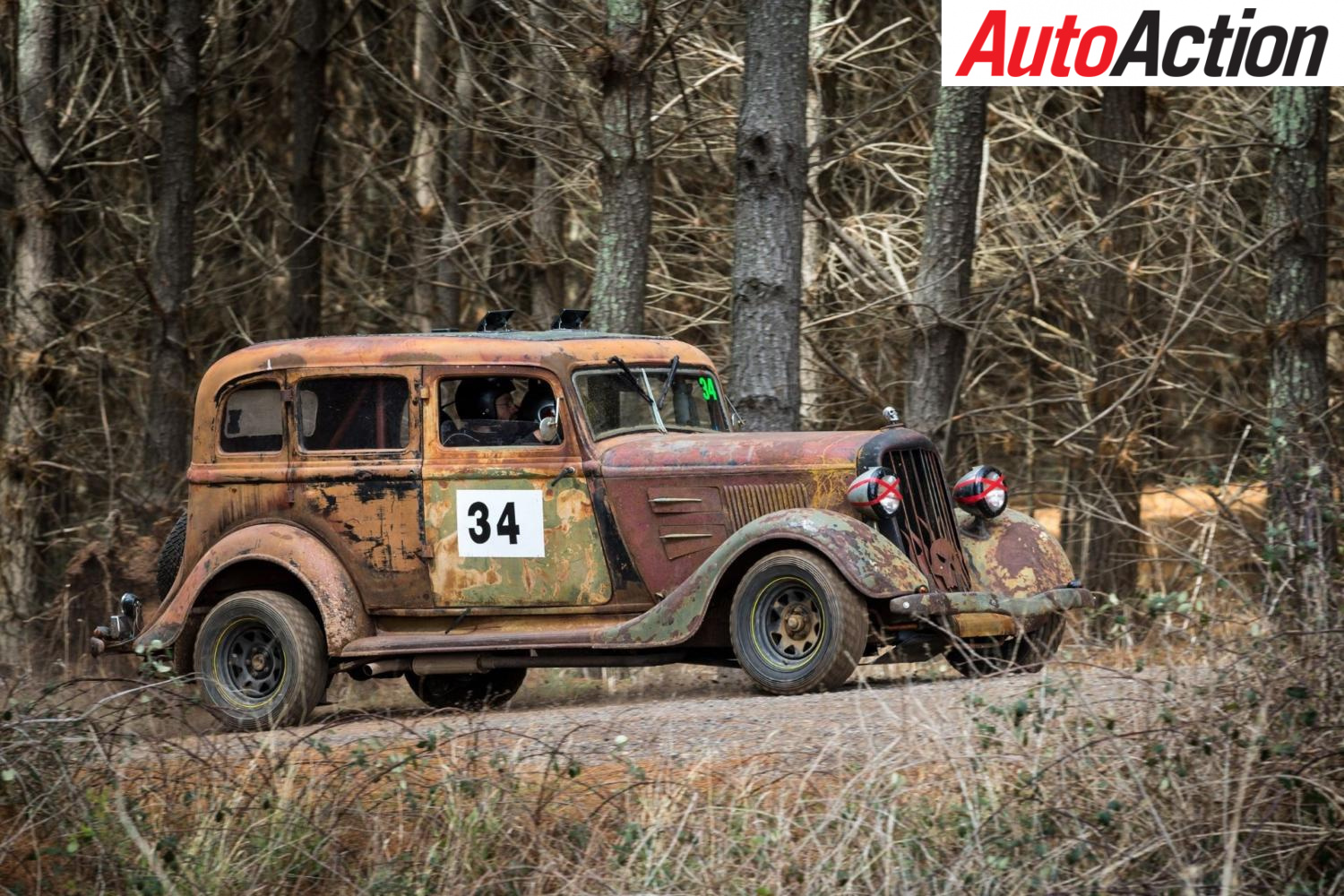

Under The Skin of Deathproof
When you think rally cars, Mitsubishi Lancer Evos and Subaru Impreza WRX STIs come to mind, and among the Historic ranks, Datsun Stanzas, Ford Escorts and Toyota Celicas are a popular choice. But, Plymouth? Michael Broholm has bucked the trend and has created a ratrod for the dirt.
By GARRY O’BRIEN
THERE IS a Classic class in the sport of rally, whether it be on dirt or tarmac, but then there is Deathproof!
Deathproof is on the outside a 1934 Plymouth, PE but what lies in and underneath is where the real story is – an enterprise that is not about being a winner, but rather a participant.
The Plymouth played a significant part in the history of Chrysler. The 1934 model signified the manufacturer’s surpassing of the one million build mark. That took just six years which was quicker than both General Motors (nine) and Ford (12) did to achieve the same milestone.
The PE was also innovative ahead of its rivals with such things as independent front suspension along with an-all steel body, hydraulic brakes, free-wheeling transmission and many other features.
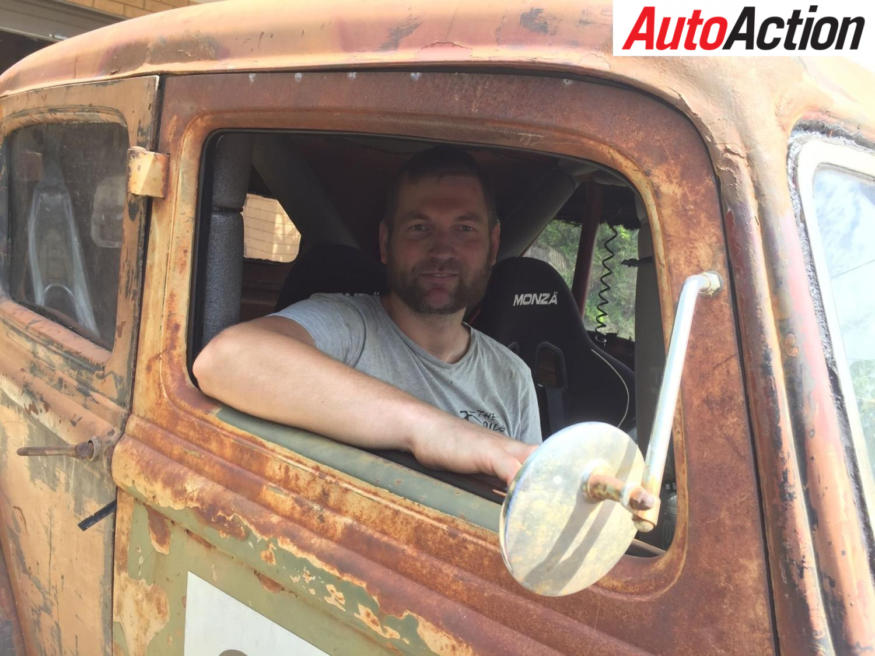
Needless to say, when Michael Broholm found this one, in the little country town of Miepoll, North West of Euroa in Victoria, there wasn’t a lot of these features left.
“I found it on Facebook, being advertised by a fellow as parts or project – bit of a pig in a poke – you didn’t know what you are getting,” he said.
It was not originally going to be a rally project, he wanted to build a rat rod. He liked what he saw immediately and literally drove down there (from Sydney) 28 hours non-stop, there and back.
It came with a HK Holden front end, but it didn’t have any springs or stub axles. The following weekend he modified the original chassis to accept the front cross member and dragged out a host of Ford bits and pieces. In no time, he had a body on wheels with two finders.
Then the project was wheeled away into a corner and lay dormant for nearly two years. “That was a far as I got, it was on hiatus for a while. It wasn’t a priority as he wanted to get it rolling, and sell or scrap what was not needed.
“I have always wanted to race a motor car but for me, I never had any idea what to race, what to race in – it was just a pipedream to me, and I have always been into the muscle cars, the hot rods and the like.”
Michael was doing some service work for a mate of his, Peter Thompson who is a member of AMSAG and runs a RA23 Celica in that organisation’s Southern Cross Rally Series.
“AMSAG is a bargain basement racing group, its good racing. You can build an absolute shit heap and have fun or build a big dollar effort and be serious. It was a motorsport category I could afford on a base wage and take it from there.”
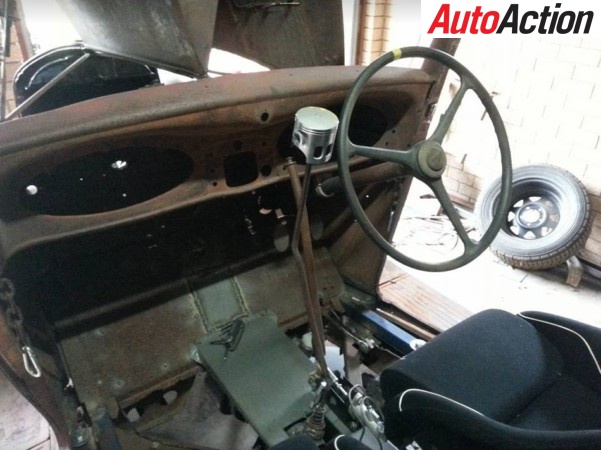
He initially thought Mustang, something V8 and lightweight. “I do like my old Fords and the squirrel started turning in my brain and I thought, I would love a rat rod, but it would be a pain in the backside and I want a race car, one I would have to engineer, and I can do what I want. So why not turn this into a race car.”
He stepped back and thought, he had all this Ford gear that he can use – some 25 cars and heaps of spares, engines, gearboxes, diffs and the like. Not only can he build it, he can replace and repair with cheap parts.
“I looked back at the placement of the engine and gearbox and it is quite far back behind the front wheels and thought this may not be as stupid as it sounds.”
The original 201ci six-cylinder side valve engine had long gone the way of the dodo and any ideas of using Chrysler powerplants like a 318 or 360ci V8 were quickly dismissed. They were too expensive and too hard to find.

Since he had around half a dozen Ford engines, literally lying around, he utilised a standard 351ci Cleveland or a 302ci with a cam. He went with the former, a ‘junker’ from a clearance auction. The single rail four-speed gearbox was a freebie that came with a parts car, as well as the diff.
“At the end of the day, I would be competing against 1970s vehicles in the Classic category of AMSAG. The rudimentary horse and cart suspension which is what is in there, XB Falcon rear end, HK Holden front end. It is all rubbish in terms of what is in the newer, modern day cars.”
In a rally car Michael figured it would have enough power, as too much would just induce wheel spin anyhow.
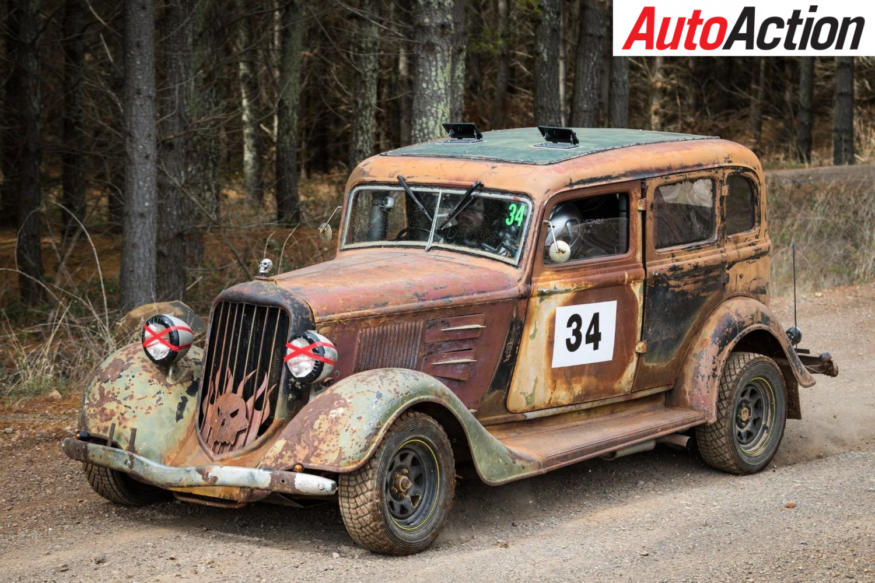
He used a Holley four-barrel 750 carburettor and the clutch is a standard heavy-duty Falcon unit.
That model Plymouth had an independent front whereas their Ford and GM rivals were still solid beam axle. The original rear leaf springs were deemed to be too narrow and the shackles were small and fragile as well.
He fitted XB/XC Falcon rear springs and a XC Falcon (Borg Warner) diff so that it became a disc brake rear. XC front and rear discs, callipers and stub axles were added and set up for the hydraulic hand brake.
The master cylinder and booster are stock XC, mounted under the floor and that has been modified to utilise the original pedals.
The radiator is original, although modified – mainly the hose fitting locations that were changed to suit the Ford V8.
MCA shocks are fitted all round (the rears were being re-gassed at the time the photos were taken), while the HK front had to be slightly modified to accept the taller shock units.
The front sway bar is XB Falcon, and it has no rear one. “Murray Coote (MCA) reckoned it was not necessary.”
It has no need for a tailshaft hoop either as the car was still had the factory-fitted middle cross member which the shaft travels through with around 5mm clearance all round.
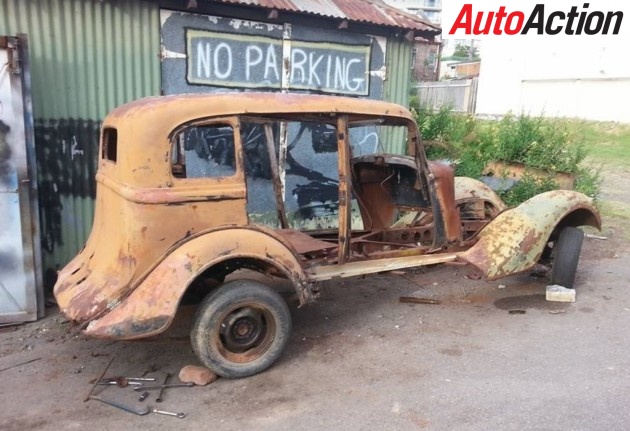
Wanting to keep as much Plymouth as was practical, it has the original steering wheel, and original steering column except the base has been modified to have a knuckle of a VL Commodore.
The rack and pinion steering was also sourced from the same model Holden. It is a power steering rack which has a tighter ratio but is not power assisted. “The steering is actually very good. Once you get past 5-10kmh, it is really easy!” Again chosen from the ease of sourcing affordable parts.
The fuel tank is original but wrapped in rubber while the Plymouth runs on rally tyres mounted on Sunraysia 15×6 generic Ford/Chrysler stud pattern alloy wheels.
Most of the panels on the car are original. But he had to purchase the running boards which are reproduction.
He also had to obtain a front grille which he couldn’t find. Eventually, he brought a truck unit of which he only used the top half while the bottom half was made from scratch to suit the sedan curvature, together with the Deathproof skull and flames.
Michael had to buy the front bumper bar along with a couple of original headlight shell/surrounds while the actual lights themselves are eight-inch H4s off a motorcycle.
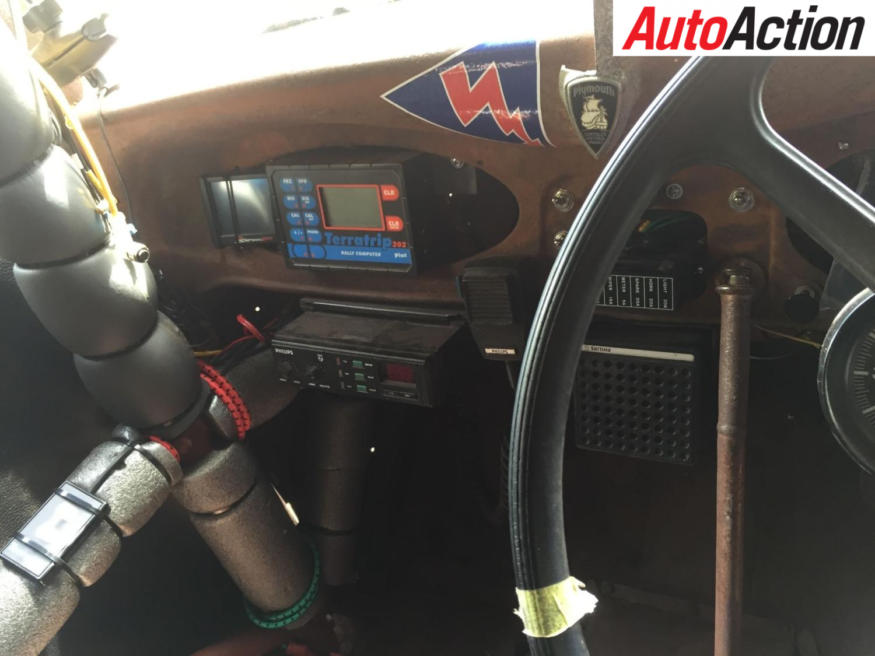
The cabin has a Terratrip rally computer, a RallySafe tracking system, Monza seats and harnesses, and a fire extinguisher.
Two factors governed the seat choice – they were cheap, and one of the only available that fitted his wide hips.
The roll cage was problematic in that he had to construct it himself because he couldn’t find anyone who would take on the job.
“No one wanted to do it, none of the big players called me back. I would tell them what I was building, and I guess they all thought I was taking the piss. There were some obscene figures being quoted too – up to $8,000.”
The windscreen wipers are a XF twin setup, replacing the original single unit. As expected the car had no glass, so it has been fitted with polycarbonate side and rear windows while the front is a single laminated glass screen. The PE model did give the impression of being a split screen because of the metal strip down the middle, but that was simply ornate.
The exhaust pipes out the side look original too, but are only the tip of a custom-made headers and pipe setup underneath the car. Also, underneath is a fabricated metal stone guard that protects the sump and other ancillaries.
Now he had his rat rod and race car in the one package. A street rod version, fully kitted and registered would weigh around 1240kgs and although it did not have any interior fittings such as carpet or door trims, it did have a cage and Michael reckoned it tipped the scales at around 1250kg.
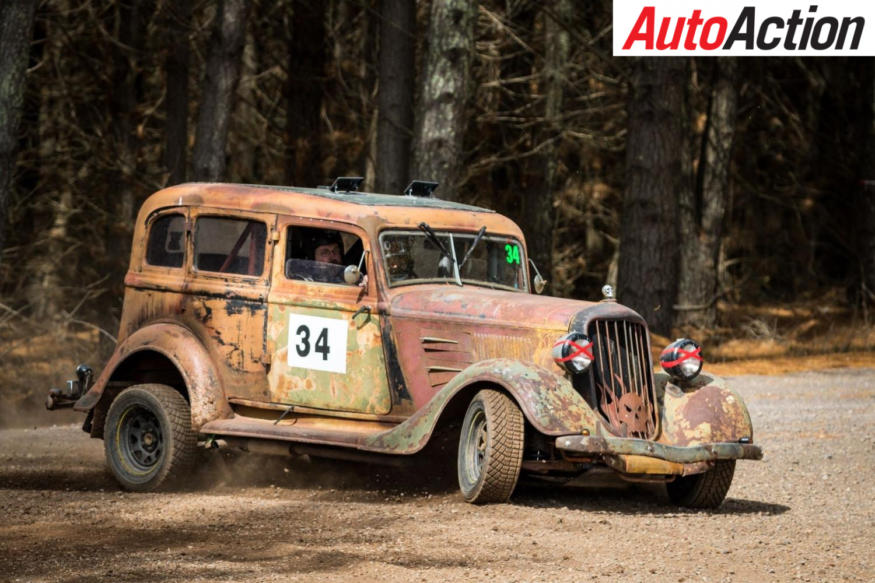
His first outing (Orange Rally) was poor because I didn’t have a decent wheel alignment, not enough caster so it was just finding its own way and he struggled to go past 80kmh before it started throwing itself to the side.
He made it halfway through the event – forced to retire when the left rear had mounting point failure. It had no rear suspension by then and was just bouncing around on the springs, and he didn’t want to destroy the shocks, probably the most expensive components on the vehicle at the time.
“Everything else felt okay and when that was fixed, I took it to the 24 Hours of Lemons at Wakefield Park and it felt really good.”
The handling felt nice too after it was attended too. Unfortunately, the car was a scratching before anyone of his team mates for the weekend managed to get a steer. The engine dumped its water when the cylinder walls broke after it pressurised the cooling system.
“I knew already that the engine was a goner after having a display run on the Friday before the event, so I just ran it until it broke – which was about 15 minutes into the event.
“It has been a sorting process as I have only done the two events. Orange was the first time I have driven a rally and my navigator had never been in a rally or navigated, and it was the first time I drove the car apart from on and off the trailer.” It turned out to be underpowered possibly because it had a very tall 2.92 ratio diff.
It was while he was attempting to affect repairs that the motor was found to be a 302ci Cleveland rather than a 351, as it had not had the heads off before.
It has since been replaced it with a 5.0-litre Windsor, married up to a T5 five-speed gearbox out of a six-cylinder Falcon which was duly modified to suit the single rail bell housing.
A new carbie has been fitted too, a EFI Holley Sniper. He felt for rallies that with the elevations and air density changes, the EFI was a better choice as it is a self-learning system, liking the idea of going where ever and not having to continually tune it.
It now has a Holley dual sync distributor and it is also controlled by the EFI. He has also changed the diff ratio, from a 2.92 to a 3.89. “It will mean a big difference in response as well as pull up the hills far better with the newer engine that has more torque and is up to much lighter than the old power plant.”
He suspects that he will have to go to a nine-inch diff at some stage and he thinks that with the new engine/gearbox combination it would be faster than the XR6 Falcon he ran at a previous Lemons.
“I want to do all six AMSAG Southern Cross Series rounds this year, participate at Lemons again – if they will have me!”
There should be no doubt of that happening and the promoter was more than keen to have Michael and Plymouth there. Michael said he really enjoys the fun event, having previously raced the XR6 there twice before, the first time with a silver baked potato livery, and the second with the car looking very much like a tweed suit.
He is also interested in doing a tarmac rally or two. “I am also interested in maybe doing a CAMS event down the track”
He did contact the governing body stating that he couldn’t find a category or class that it would fit into. “They actually got back to me with a tentative green light, saying they would be happy for me to run it in 3C for rally cars of significance or providence.”
“You don’t have to be a sheep and follow what everyone else is doing. I liked the idea of creating something different and I hope it is an inspiration for others to follow.”
Tech Specs
1934 Plymouth PE Rally Rod “Deathproof”
Engine
Ford 331 stroker, 5.0-litre Windsor
GT40p heads with Yella Terra roller rockers
Holley Sniper EFI carburettor
Dual sync distributor on Edelbrock Air gap Manifold
Dual side exit exhaust
Power: 400hp (300kw) at Flywheel
Torque: unknown
Gearbox
Ford five-speed T5
Diff
XC Falcon Borg Warner limited slip. 3.89:1 ratio
Chassis
Standard 1934 Chassis, with eight-point roll cage and modified mounting points for suspension and engine
Interior
ZG Fairlane instrument cluster, Autometer Tacho, Holley Sniper touch screen display, terratrip, RallySafe GPS
Monza Race seats with six-point safety harnesses
Standard steering wheel and pedals retained and adapted to suit modified brakes and steering rack
Polycarbonate side and rear glass. Laminated front screen
Suspension
Front: Independent double wishbone and crossmember from HK Holden, with custom made coils and MCA Gold shocks, and 22mm XA-XC falcon sway bar and links
Rear: Live axle, XA-XC falcon leaf springs with MCA Gold rear shocks and XE-XF falcon watts link.
Steering
Non-power assisted, power steering rack from VL Commodore, mated to stock column
Brakes
Rear: XC falcon ventilated disc with braided steel lines
Front: XC falcon stub axles and ventilated discs with braided steel lines
XC falcon under floor mounted master cylinder and booster
Fuel System
Stock tank with XC Falcon sender and added lines to suit EFI and surge tank
Dimensions
Length: 4,780mm
Width: 1,745mm
Height: 1,685mm
Wheelbase: 2920mm
Track: Front: 1545mm, Rear: 1560mm
Weight: 1250kg unladen
Article originally published in Issue 1729 of Auto Action.
For our latest Under The Skin feature pick up the current issue of Auto Action Magazine, on sale now. In the meantime follow us on social media Facebook, Twitter, Instagram or sign up for our weekly email newsletter for all the latest updates.


